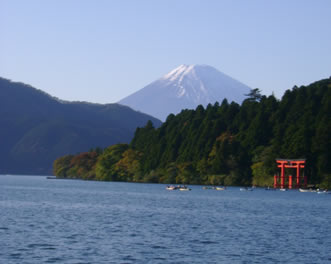Articles on Japan, Links & Reviews
Travel in Japan
Popular Day Trips from Tokyo - Hakone
In between Mount Fuji and the Izu Peninsula lies Hakone - about 80 kilometers west of Tokyo and attracting about 19 million visitors each year. It is a mountainous region whose form has changed over the years with volcanic activity and eruptions, and was also the historical checkpoint on the road linking eastern and western Japan. Today, it is known as the nearest onsen resort area to Tokyo but boasts numerous attractions and holds up to its claim as a must see in the Kanto area.
There are many attractions in the area. Here are some of the major sites of interest:
Hakone Open-air Museum
This was the first open-air art museum in Japan and features works from world renown artists including Rodin, Bourdelle, Miro, and one of the largest collections of British sculptor Henry Moore. There is also a Picasso Pavillion with a collection of over 300 pieces. The Hot Footbath spa (free-of-charge) makes a nice relaxation stop as it will take a couple of hours to walk around and enjoy the grounds.
http://www.hakone-oam.or.jp/eng/
Lake Ashi
A crater lake, "Ashi-no-ko" is known to be one of the best viewing spots for Mount Fuji - though that is dependent on it being a clear day - visibility is usually better in the colder seasons. Sightseeing boats can be taken over the lake and many visitors stay at nearby resorts in the area as the Hakone Ropeway can be caught from the lake (Togendai Station). For a first dramatic view of Mount Fuji, take the ropeway up to Owakudani Valley from the other side of the mountain before heading down to Lake Ashi.
Hakone (Jinja) Shrine
Hakone (Jinja) or shrine was constructed in 757 and hosts crowds of worshippers during New Year celebrations. The Hakone Daigongen - local deity of the Kanto region - is enshrined at this temple, and other exhibits housed in the Jinja Shrine Treasure Museum include the daggers which belonged to the Soga brothers (the heroes of one of the country's most famous historical vendettas). The unmistakeable red "torii" gates leading up to the shrine can be seen at the edge of Lake Ashi.
Hakone Kowakien Yunessun
The region itself is dotted with several onsen (hot-springs) however if you're looking for something a bit more extraordinary you may want to visit this hot spring "theme park". Their spa resort services and water attractions are for both young and old. The wide variety of baths include "Roman style", "Turkish style", traditional Japanese baths, and even the more unusual coffee, wine, and green tea baths to name a few.
http://www.yunessun.com/
The Owakudani Valley (The Great Boiling Valley)
Previously named the "Valley of Hell" the Owakudani Valley was created by the last vaporous eruption of the Hakone mountains about 3000 years ago. Kuro-tamago or "black eggs" are cooked in the hot sulfur springs which steam up around the mountain. There is a short "hike" up a path to the hot springs site (about 1 kilometer) where you can also buy the eggs. Eating one is said to extend your life by 7 years. The fact that they are sulfur springs won't pass you by as you can smell them even as you approach the site.
Links of Interest
Hakone Navi
- http://www.hakonenavi.jp/english/
National Park Hakone
- http://www.hakone.or.jp/english/
Japan National Tourism Organization - http://www.jnto.go.jp/eng/

Lake Ashi with Mt. Fuji in the Background
Getting to Hakone:
-
Getting to Hakone like most tourist destinations in Japan is not difficult. There are several tour operators who offer packages or group tours, or you can use public transport quite easily. A relatively straight forward route from Shinjuku is Shinjuku-Odawara-Gora.
- Shinjuku to Odawara will take you just over an hour on an express train. From Odawara the Hakone Tozan line will stop at various towns in Hakone, and Gora is the terminus at the end of the line. From Gora you can take the Tozan Cable Car to Sounzan. The cable car is a funicular railway climbing you back and forth up the mountain making several stops along the way at different attractions (including the open-air museum). Once at Souzan you can then go on to take the Hakone Ropeway (www.hakoneropeway.co.jp/) - a gondola system which runs from Sounzan to Lake Ashi (it also stops at Owakudani).
- There is also a Hakone Free Pass that will allow you unlimited use of most transport for 2-3 days. www.odakyu.jp/english/
In addition to Japan's Premier Shop Directory, English OK! offers the following services:
Customer Service English Training: Onsite Workshops, e-Learning & Books
Multilingual Website Design

